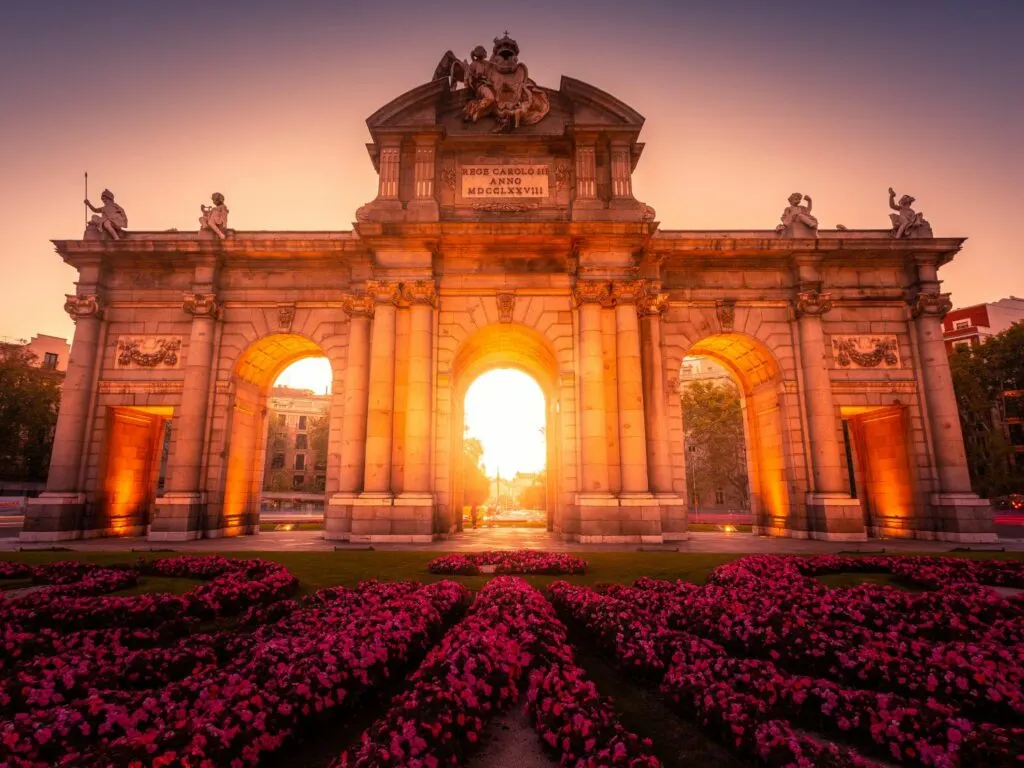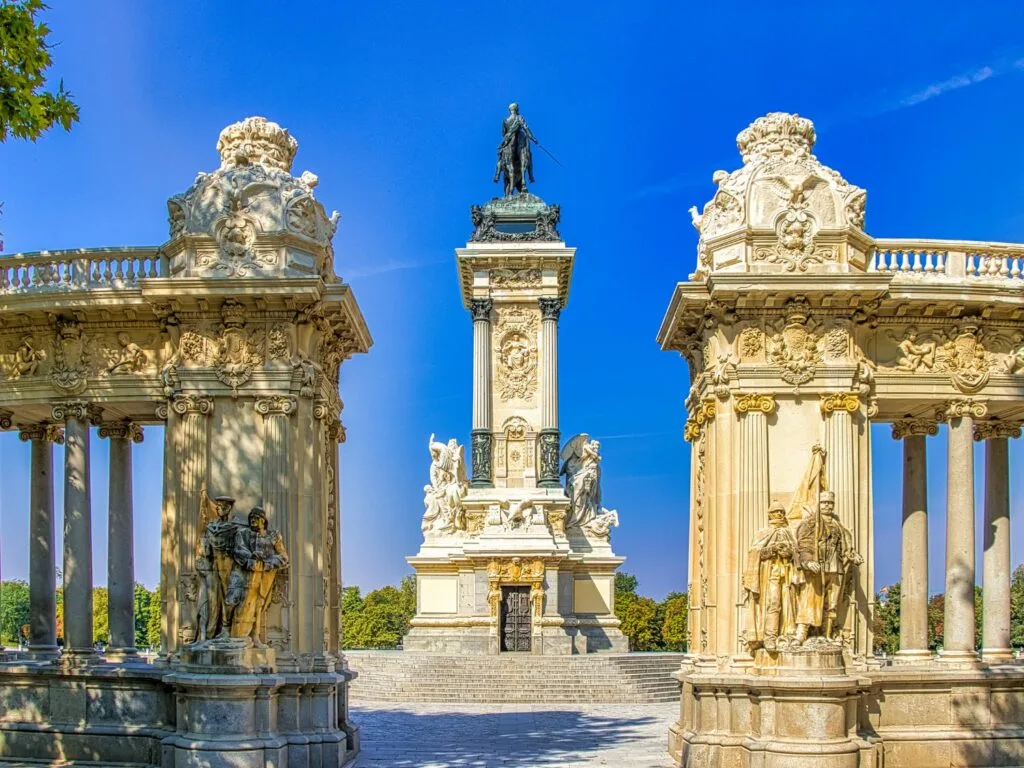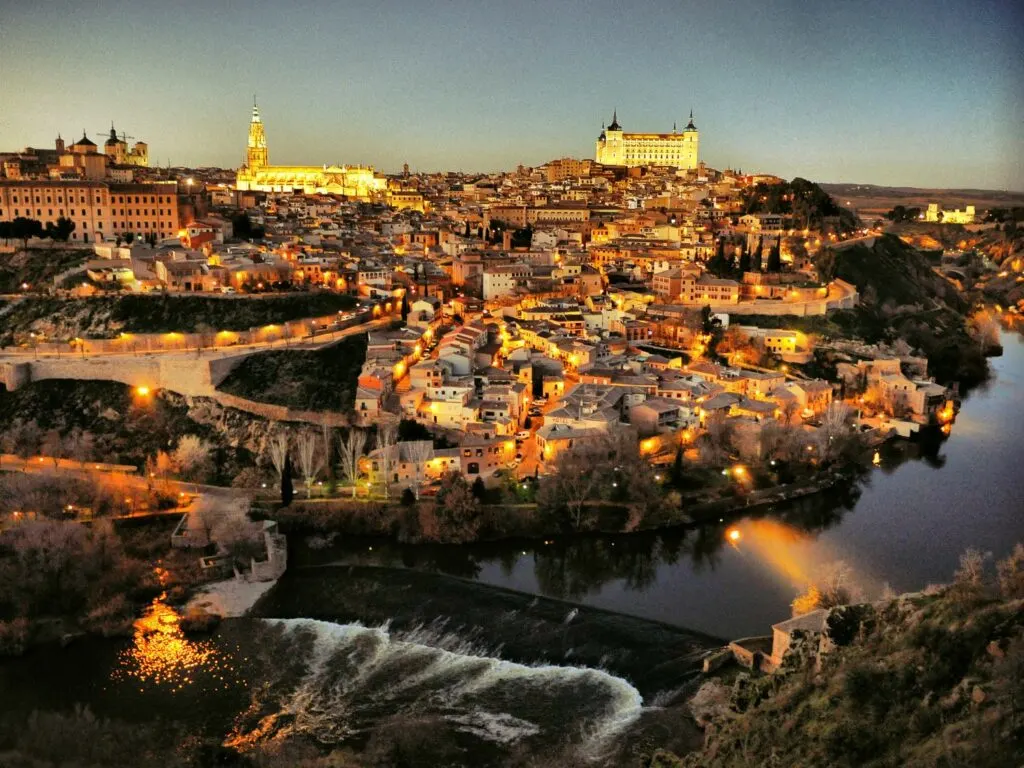Sofia De Vera combines a heartfelt passion for cinema with over 15 years of critiquing for esteemed film publications, wielding academic credentials from the University of Southern California and New York University, to serve as your personal guide through the enchanting worlds of film and television. Her full guest bio can be found here.
Madrid has a lot to offer for both national and international filmmakers. The city is known for its architectural treasures, and for being a epicenter of art. It is also well known for its culture and vibrant nightlife, and of course, flamenco dancing! So it will come as no surprise that there are so many wonderful movies set in Madrid.
Madrid is one of those rare cities where people are as forward-thinking as it gets, but also have much pride in their traditions. It’s no surprise that it’s the capital of Spain. Multiculturalism and heritage combine in such a charming way that could only be seen in a European city. If you haven’t added Madrid to your must-go places, you should get on it.

Any local can tell you that Madrid and the sunshine go together. That’s why everyone will advise you to visit the city during summer. It’s a time of much drinking and dancing, either at one of the many music festivals or on the cobblestone streets. Madrid is a great place to party: its vivid nightlife will see you through some of the best nights of your life.
When it comes to traveling, Madrid often finds itself overshadowed by Barcelona. This is great for anyone who wants to visit the city because it means that there are fewer tourists—more of this beautiful city for you! You can jump right into the mood by taking a look at the films on this list. Some are new, some are old, but all of them are distinctly Spanish.
These best movies set in Madrid have narratives that rely on their settings as much as their main protagonists, and as a result, spectators get a glimpse of this iconic country through the director’s eyes. To honor the concept of cinematic travel, we have also assembled lists of our favorite films shot in some of our all-time favorite travel destinations: Vancouver, Moscow, Dubai, Florence or Budapest.
Wondering where to watch? It depends on where you live in the world and which streaming services you have. We link to the streaming service we watch on in each case - be it Netflix, Amazon Prime, Apple TV+, or elsewhere.
You can get one month free of Amazon Prime (or a 6-month trial for students) of Amazon Prime and also get immediate access to FREE Two Day shipping, Amazon Video, and Music. While you won't be charged for your free trial, you'll be upgraded to a paid membership plan automatically at the end of the trial period - though if you have already binged all these, you could just cancel before the trial ends.
Apple TV+ also has a one-week trial, and Hulu has a one-month trial (which can be bundled with Disney!). Another option might be using a VPN to access Netflix titles locked to other regions. Netflix is now available in more than 190 countries worldwide and each country has a different library and availability. US Netflix is (understandably) one of the best.
While we wish everything could just be in one place - for now, it seems these are the best streaming platforms to watch on.
Page Contents
- Women on the Verge of a Nervous Breakdown [Mujeres al borde de un ataque de nervios] (1988)
- Open Your Eyes [Abre los ojos] (1997)
- Dark Blue Almost Black [Azuloscurocasinegro] (2006)
- Perfect Strangers [Perfectos desconocidos] (2017)
- Truman (2015)
- May God Save Us [Que Dios nos perdone] (2016)
- Operación Ogro (1979)
- Viridiana (1961)
- Dream of Light [El sol del membrillo] (1992)
- Death of a Cyclist [Muerte de un ciclista] (1955)
Women on the Verge of a Nervous Breakdown [Mujeres al borde de un ataque de nervios] (1988)
You’d be hard-pressed to find a more iconic Madrid movie than Women on the Verge of a Nervous Breakdown, which is why it’s the best place to start this list. Of course, the film was made by Pedro Almodóvar, the Spanish genius behind some of the most powerful comedies and dramas to be made in the country.
If you aren’t familiar with his work, this film is a perfect place to start—although you shouldn’t miss Law of Desire, which is also set in Madrid! The film features some stellar performances by some of Spain’s greatest actors, chief among which are Carmen Maura and Antonio Banderas.
Women on the Verge of a Nervous Breakdown is loosely based on a play by Jean Cocteau where a woman tries, again and again, to convince her lover not to leave her by calling him through her phone. However, the movie plays out in a way much different from its source material: it sees two voice actors, Pepa (Maura) and Iván (Banderas), break up after being together for quite a while.
As Iván goes on a trip, Pepa tries contacting him but doesn’t know where to call. She’s quickly joined by her friend, Candela (María Barranco), who is having a nervous breakdown. As the movie goes on, Pepa encounters more and more women who are on the verge due to heartache.
After a tumultuous ride, Pepa will learn to put herself first. The film earned a nomination for Best Foreign Language Film at the Academy Awards and won five Goya Awards (the most coveted price in the Spanish film industry).
Open Your Eyes [Abre los ojos] (1997)
One of Spain’s most interesting directors to date, Alejandro Amenábar has managed to explore different genres of films while preserving what makes him so great: his passion for the human experience.
From his diverse cinematography, you may have seen The Others, the chilling gothic ghost story starring Nicole Kidman. Or maybe the Academy Award-winning drama Sea Inside, which shows a quadriplegic Javier Bardem trying to stay alive after an accident at sea.
Open Your Eyes, was his first film, and it’s not as popular as the other ones. Although perhaps you’re familiar with its worse yet more popular American remake: the Tom Cruise-led Vanilla Sky.
Even if you have seen the remake, do yourself a favor and watch the original. You’ll get to see the beginnings of a master of filmmaking. You’ll also experience the city of Madrid as you’ve never seen it: mysterious and captivating, like a dream.
The movie is told in a very interesting way, mixing reality with dreams as the story unfolds. Open Your Eyes starts with César (Eduardo Noriega), a man who first appears to be dreaming but turns out to be in prison. As he tells his story, the audiences get to see his past.
When a jealous ex-girlfriend is driving him home, she tries to kill both of them by crashing the car. He isn’t only disfigured; he also starts to hallucinate and see visions of the past and future. The film is constantly playing with the idea that he has to open his eyes in order to see the real world. But that turns out to be harder than it sounds.
Dark Blue Almost Black [Azuloscurocasinegro] (2006)
Dark Blue Almost Black is a comedy-drama film by Daniel Sánchez Arévalo. It was his first feature-length film. That is a hard time for any director, but for him, it was even worse: he had graduated with a degree in Business Management and had just been learning about cinema in a master’s course.
The movie began as a short film titled “Physics II”. It told a small part of the life of a character called Jorge who, like Arévalo, had a degree in Business Management. Once he had shown the movie in festivals, the director felt that he wanted to return to the character and tell the whole story.
Jorge (Quim Gutiérrez), is a young man in his twenties who works as a doorman in a building in the center of Madrid. Although he has just graduated, he still has to work the job in order to keep a steady income coming in for his father. After his old man suffered from cerebral infarction, Jorge had to take care of most things.
The film sees Jorge meeting a woman named Paula (Marta Etura). She’s a charming girl who he gets along with. There’s only one problem: she’s in prison. They were introduced by Jorge’s brother, who is also locked up in that penitentiary. As if that weren’t enough, she asks Jorge to get her pregnant so that she can be moved somewhere else and escape the abuse she suffers there.
Dark Blue Almost Black becomes much darker than one would initially assume. Yet it still manages to make you smile with its charming characters and little human moments. It has a bittersweet yet happy ending.
Perfect Strangers [Perfectos desconocidos] (2017)
Another key figure when it comes to Spanish cinema is Álex de la Iglesia, a fascinating director who tends to mix his favorite genres —horror and comedy— every time he can. Perfect Strangers isn’t much of a horror film, but it is very funny.
It’s a remake of a French film of the same name by Paolo Genovese. Those who have seen both movies tend to agree that de la Iglesia’s version is the superior one, but you’ll have to be the judge.
Perfect Strangers sees three couples and a single friend deciding to play a very peculiar game at a dinner party. The rules are that, during that night, everyone will have to read any message that they get on their phone aloud. If they happen to get a phone call, they have to put it on speaker and let everybody hear what they are being told.
After having a couple of drinks, all of them are on board with his silly game. But quickly, they will find that things told in the privacy of a text message shouldn’t be read out loud. As incriminating messages and phone calls come in, the evening turns into a disaster.
The film is the perfect chance for anyone who isn’t familiar with Spanish cinema to become acquainted with its many popular faces. While some, like Eduard Fernández or Belé Rueda, give some of the best performances in their lives, others just do what it’s necessary. Perhaps the best role is that of Antonio (Ernesto Alterio), the only single person in the friend group and the one with the most to hide.
Truman (2015)
This comedy-drama by Cesc Gay surprised most people who watched it. Even though Gay has had a long career as a writer and director, and even taking into account the star quality of the Argentinian Ricardo Darín, nobody was expecting this movie to be such a big hit.
Truman tells the story of Julián (Darín), an actor living in Madrid with his wife, Paula (Dolores Fonzi), and his dog, Truman. He has been fighting against cancer for over a year, but he feels like he won’t get better. There seems to be nothing left to do.
One day, the couple receives an unexpected visitor: Tomás (Javier Cámara), a friend of his who works in Canada as a teacher. Julián is delighted to see his friend, almost forgetting about his other worries. They decide to spend a couple of days together until Tomás has to go back to his job.
After spending four long days joking and talking about their past, Julián decides that it´s time to tell both Tomás and Paula that he wants to have an assisted suicide. The others are shocked, but they don’t know what to do. Little by little, they come to terms with Julián’s decision. His last request to his friend is that he takes Truman with him.
Perhaps it was the dog, perhaps it was the cancer, but Truman managed to captivate the hearts of the entire nation. Particularly those of critics. The film was nominated for many awards, and it ended up winning the principal five Goya’s (the most prestigious Spanish film prize): each actor got an award, and Gay took home the statuettes for Best Director, Best Screenplay, and Best Film.
May God Save Us [Que Dios nos perdone] (2016)
May God Save Us is one of the best thriller films ever made in Spain and a total must-watch for fans of crime movies. Both directed and co-written by Rodrigo Sorogoyen—with the collaboration of Isabel Peña, this film is not for the faint of heart, nor is it for people who don’t want to see graphic violence in a movie. If you’re neither of those people, keep reading.
The film tells the story of two cops who are trying to catch a serial killer known for abusing and killing older women. Both of them want to catch him even if it’s the last thing they do, but they can’t get along with each other.
While Luis Velarde (Antonio de la Torre) is a shy man on the autistic spectrum, Javier Alfaro (Roberto Álamo) is a brazen and violent individual who is on thin ice after assaulting another officer. The tensions between the two of them escalate as Alfaro sees Velarde working: he lies just like the victims were in order to better understand what happened.
Very early in the investigation comes a time when they get very close to the killer. But the film is set during the summer of 2011 when a series of protests against exorbitant wealth coincided with the arrival of Pope Benedict XVI to Madrid. So, the crowds of people make for a perfect place for the killer to hide.
When they are about to catch the killer, he strikes back where it hurts. May God Save Us didn’t win any awards, but Roberto Álamo did. He won three awards for Best Actor in different festivals throughout Spain.
Operación Ogro (1979)
This documentary is for those who are obsessed with learning about the history of the places they want to visit. Spain has lots of history to offer: classic romances during the Middle Ages to the war against pirates and the colonies. Yet this film takes place a little closer to this day and age: in 1973.
The film’s title wasn’t translated into English when it was released, but it means “Operation Ogre”. “Why is it called like that?”, you may ask.
“Operación Ogro” was the real name of an operation to kill Luis Carrero Blanco, a Navy officer, and the Prime Minister during the dictatorship of Francisco Franco, who was also known as “ogre”. The operation was conducted by ETA, a separatist group that fought for the right of the Basque Country to exist separately from either Spain or France.
While at first, they were known only to spread awareness about their fight, with time, they became a paramilitary group that assassinated many people. Not only did they fight against Spain during the time of Franco, but up to 2011, when they declared a definitive cease-fire.
The film dives deep into this key moment in the story of Spain. It’s told through the eyes of the policemen who were escorting Carrero Blanco when the explosion took place.
The terrorists spent five months digging a tunnel under the road so that they could plant the explosives where the Prime Minister’s car was going to pass through. As result, when the bomb went off, the car that Carrero Blanco was riding in rose through the air and ended up on the terrace of a building.
Viridiana (1961)
There is one of the greatest Spanish movie directors yet to be mentioned, but his time has finally come. Luis Buñuel was a master of cinema like very few others. An earlier collaborator of Salvador Dalí and one of the founders of the surrealist movement, he explored all kinds of ways of making cinema.
If there’s something common in his diverse work it is his guts: he was always a subversive person who dared to push the art form forwards rather than letting it stagnate.
Viridiana is one of the best movies set in Madrid based on an 1895 novel by Benito Pérez Galdós called Halma. Both book and film tell the story of a novice nun called Viridiana (Silvia Pinal) who, just when she’s about to take her vows and become a fully-fledged nun, is invited by her uncle to visit him. Forced by the mother’s superior, Viridiana accepts.
But there she finds that his only reason for inviting her was to have sex with her. After refusing him again and again, Viridiana sets out to leave. As she’s about to board the bus, she hears that her uncle has hanged himself out of shame. This prompts her to stay in the family estate, where she meets her illegitimate cousin, Jorge (Francisco Rabal).
Viridiana is considered to be one of his greatest films: a Palme d’Or winner, the film received praise from almost everyone. Almost. There were a few that didn’t want the film to exist. The Spanish board of censors forced Buñuel to remove the original ending where it was suggested that Viridiana had sex with Jorge. Instead, the new ending implied that she had sex with both Jorge and the maid.
Dream of Light [El sol del membrillo] (1992)
This captivating film is neither fiction nor a documentary. The film was directed by Víctor Erice, who is considered to have made one of the best Spanish films ever, El Sur. It’s a captivating meditation on art and the artists: the relationship between what’s eternal; art, and what’s not; people.
Dream of Light follows real-life painter Antonio López García as he attempts to capture in paint a quince tree that he had planted in his backyard years ago. The film offers many interesting insights into the mind of artists since it shows the audience how a painting is made from start to finish. During this process, López García talks about his reasoning for every little decision he takes.
About halfway through the film, López García has a friend over, and the two of them discuss the work of Michelangelo and how much his story inspires them. At this moment, the true nature of the film can be seen: the painter reflects on the age that Michelangelo was when he painted one of his most famous works. And he can’t help but feel intimidated by the prospect of death.
The struggle with the idea of death takes center stage: López García is trying to rush the painting because the quince is starting to rot. Things are dying, and he can’t do anything to stop them. Don’t worry, the film doesn’t end on a sour note. As the ending of the film draws near, we get to see the painting finally finished.
Even though it wasn’t the audience who painted the painting, it does seem like an accomplishment that you and López García achieved together.
Death of a Cyclist [Muerte de un ciclista] (1955)
Death of a Cyclist is a film that’s inscribed in the social realist art movement, meaning that it strives to portray life in a realist way. But it doesn’t do so just to document reality. Social realist works have a message of critique behind their realistic aesthetics. And that´s what Death of a Cyclist is all about.
The film was made by Juan Antonio Bardem, a very important Spanish filmmaker who is known for being a part of the Communist Party and working to spread its ideology through his movies—as a side note, he was also the uncle of Javier Bardem. With Death of a Cyclist, he found international fame, mostly thanks to it winning the FIPRESCI Award at the Cannes Film Festival.
The movie follows a couple of lovers who, after returning from having an affair out of town, run over a cyclist, killing him. At first, they aren’t sure if he is dead, but the news around town begins to spread, and they learn that he is.
The two of them start to crack under the pressure of their crime being discovered: María José (Lucía Bosè) is scared of losing her husband, and Juan (Alberto Closas) feels like a hypocrite for having abandoned the fight for a socialist republic.
The film will see the couple becoming more and more guilty, to the point where they are ready to turn themselves in. But in this trying time, the couple itself will break.




